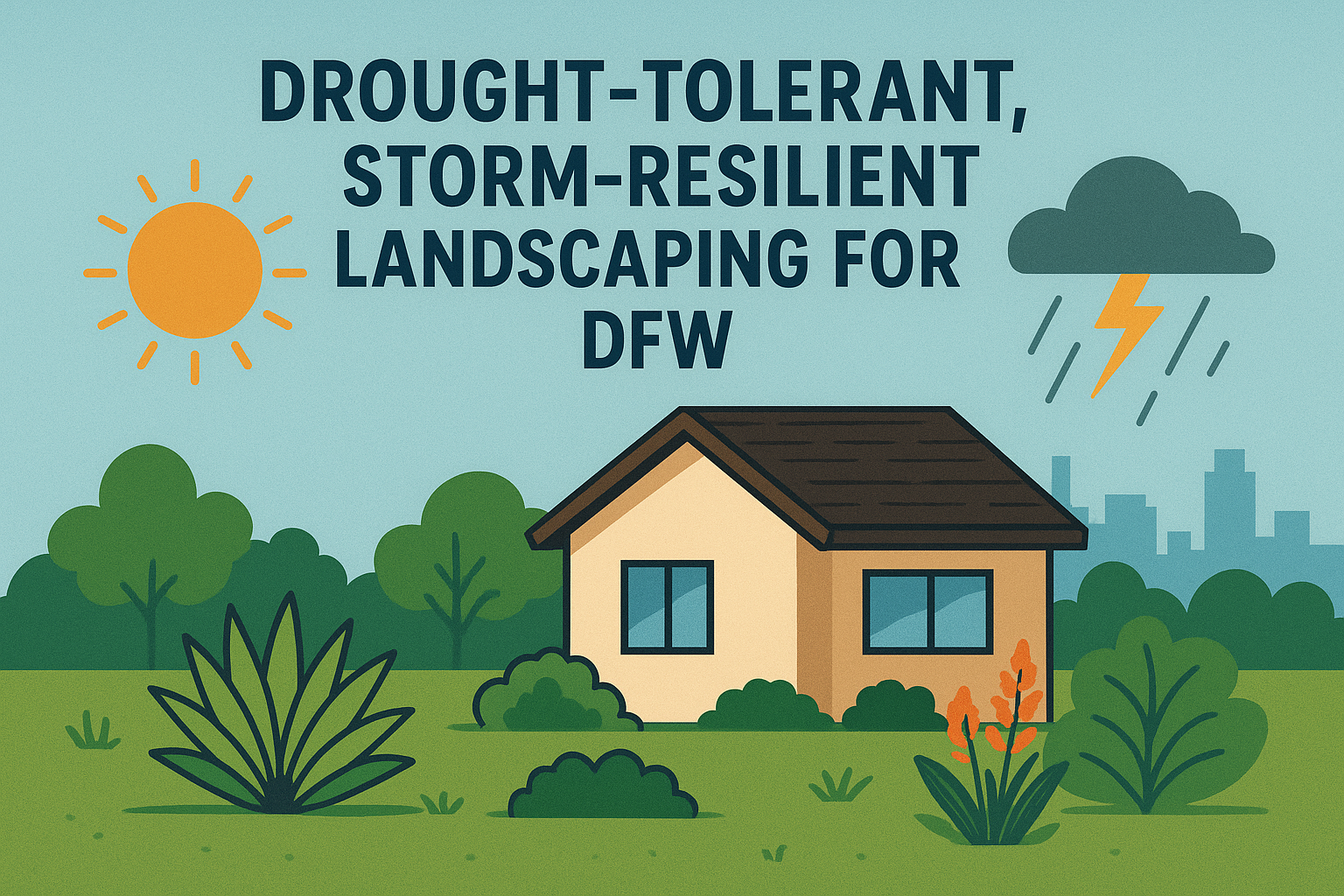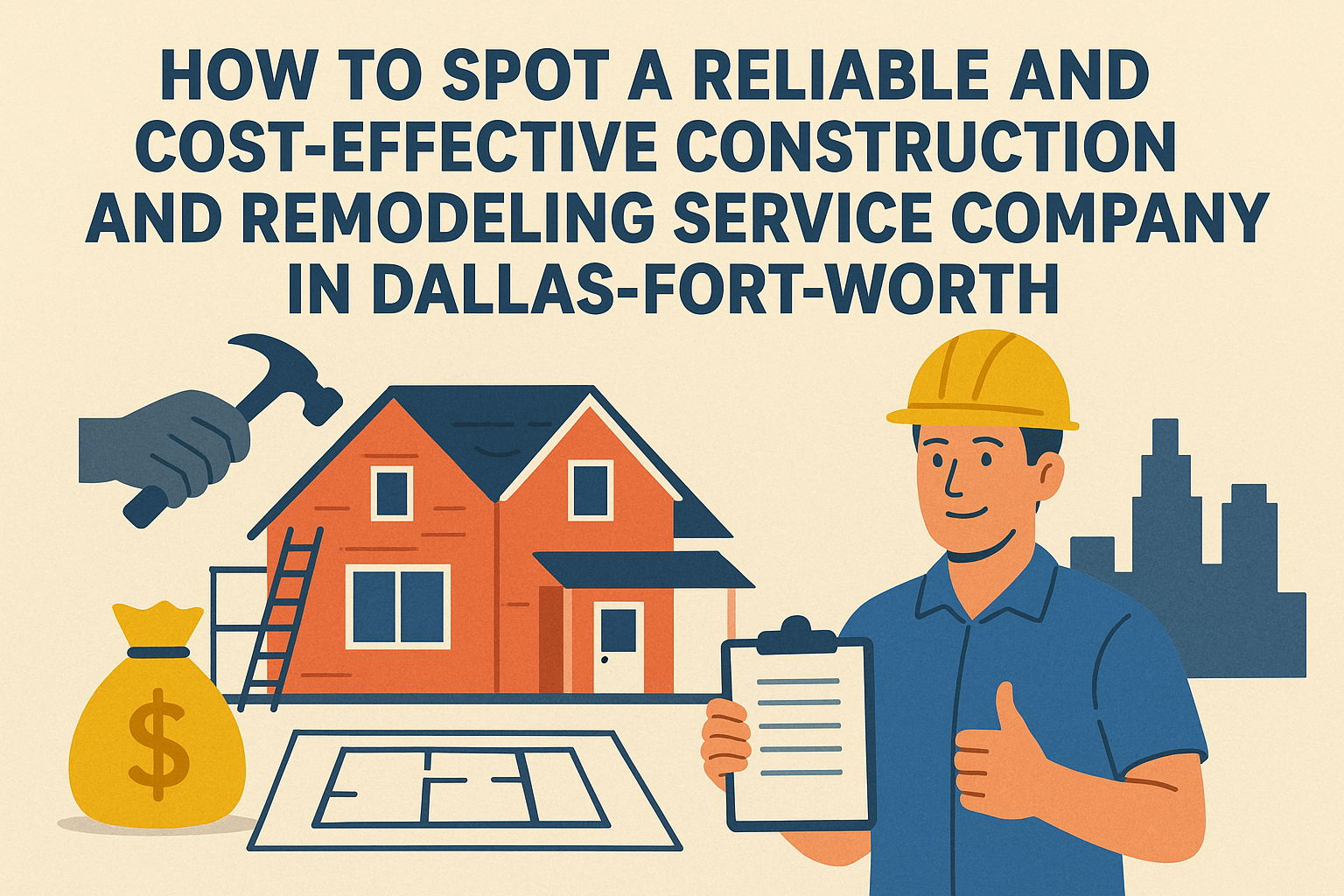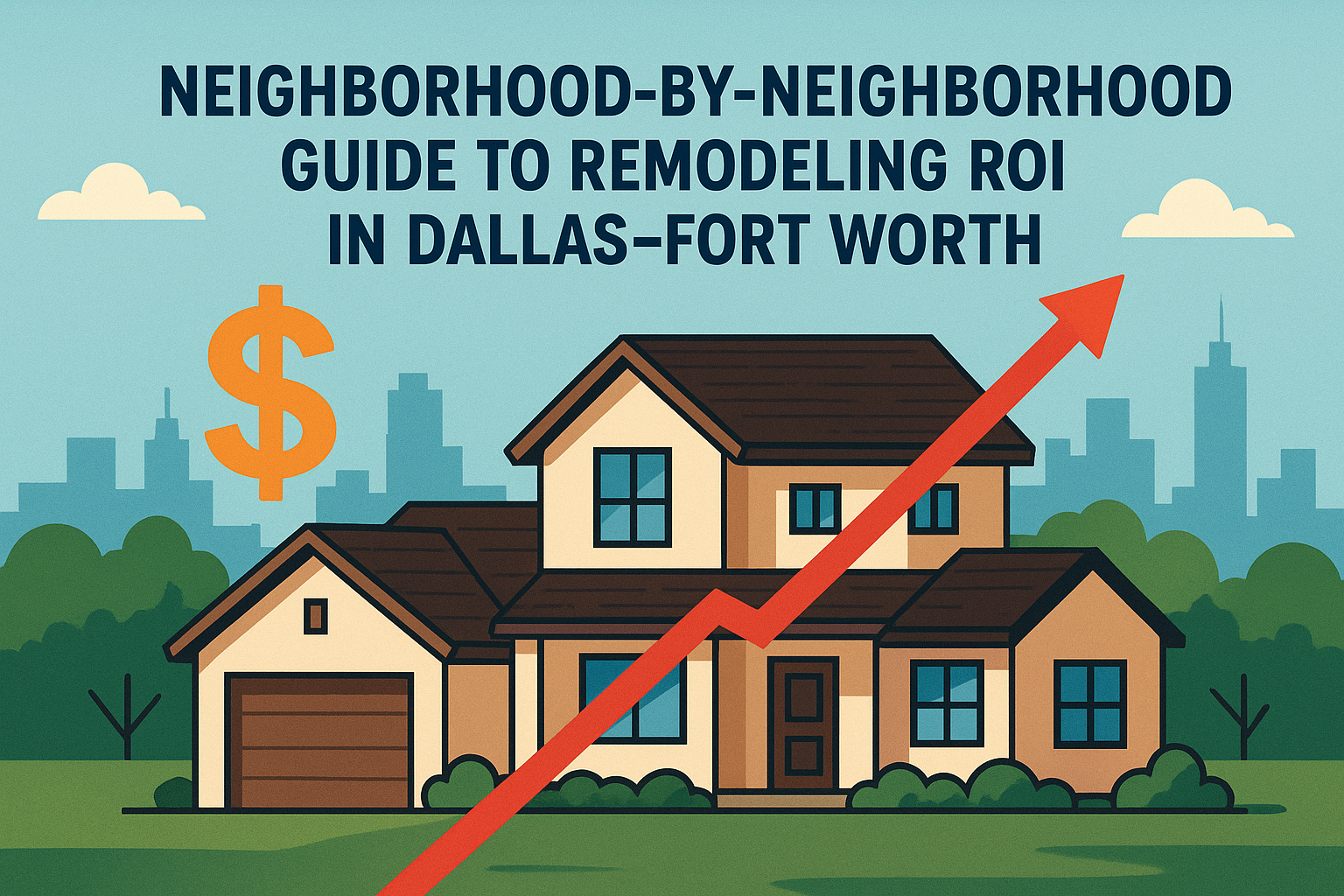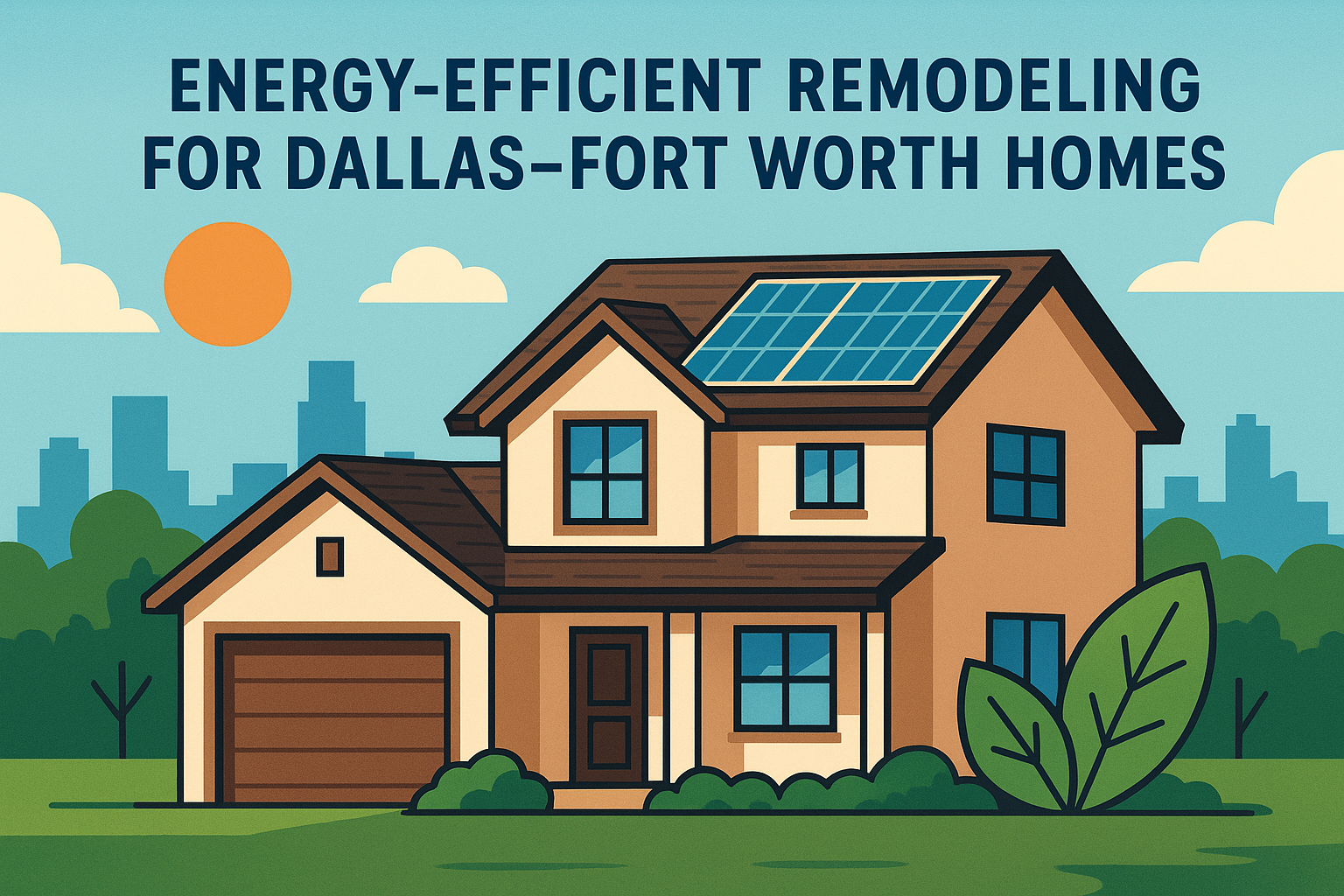Drought-Tolerant Landscaping and Storm-Resilient Hardscaping for Dallas–Fort Worth Homes
Practical guide to drought- and storm-ready landscaping in Dallas–Fort Worth: plants, grading, drainage, hardscape, nurseries.

Dallas–Fort Worth (DFW) homeowners face the twin challenges of prolonged drought and intense storm events. Designing landscapes that use less water while standing up to heavy rain, runoff, and erosion is now essential for long-term property protection and cost savings. This practical guide walks you through drought-tolerant landscaping and storm-resilient landscaping strategies for Dallas Fort Worth homes: plant lists (including Texas native plants and low water use plants native to north Texas), grading and drainage strategies, erosion-control hardscape ideas, estimated water- and maintenance-savings with xeriscape approaches, and recommended local nurseries and landscape contractors in Dallas Fort Worth.
Table of Contents
- Understanding DFW climate and site assessment
- Choosing a target approach: xeriscape, native palette, or hybrid
- Best drought-tolerant plants for Dallas Fort Worth (plant lists)
- Low maintenance plant combos and planting tips
- Grading and drainage strategies for DFW homes
- Erosion control hardscaping ideas for Texas yards
- Estimated water and maintenance savings with xeriscape landscaping
- Local nurseries DFW and recommended landscape contractors Dallas
- Implementation checklist and phased project plan
- Expert insights and final recommendations
Understanding the DFW climate and performing a site assessment
DFW sits in the north-central region of Texas with hot, dry summers and occasional heavy rainfall events (often in short bursts). Local soils vary from clay to sandy loams — many DFW yards have compacted clay that drains poorly and is erosion-prone when water concentrates. Before planning, perform a site assessment:
- Note sun/shade patterns, microclimates (hot southern exposures, cool shaded north sides).
- Identify existing drainage paths, downspouts, and low spots.
- Map slopes and measure grades away from foundations (recommended minimum slope: 1–2% away from house).
- Take soil samples (texture and infiltration) and check for compaction.
- Record mature tree roots and protected species.
Choosing a target approach: xeriscape, native palette, or a hybrid
Three practical approaches:
- Xeriscape (water-saving landscaping): Use grouping by water need (hydrozoning), mulch, efficient irrigation, and drought-tolerant species. Ideal for maximum water savings.
- Native palette (Texas native plants for sustainable landscaping): Prioritizes species adapted to local soils and climate; often low maintenance and wildlife-friendly.
- Hybrid: Combine native trees and shrubs with ornamental drought-tolerant perennials and hardscaping for aesthetic variety and resilience.
Best drought-tolerant plants for Dallas Fort Worth (by category)
This plant list prioritizes Texas native plants and low water use plants native to north Texas, drought tolerance, storm resilience, and low maintenance.
Trees
- Cedar Elm (Ulmus crassifolia) — native, drought-tolerant and wind-resistant.
- Texas Red Oak (Quercus buckleyi) — native, deep roots, good shade.
- Chinkapin Oak (Quercus muehlenbergii) — drought-tolerant, durable.
- Mexican Plum (Prunus mexicana) — small native tree with spring blooms.
- Anacua (Ehretia anacua) — tolerant of drought and storms.
Large shrubs and small trees
- Yaupon Holly (Ilex vomitoria) — native, evergreen, salt and drought-tolerant.
- Texas Sage / Cenizo (Leucophyllum frutescens) — popular, low maintenance.
- Possumhaw Viburnum (Viburnum nudum) — wet/dry tolerant, wildlife-friendly.
- Flame Acanthus (Anisacanthus quadrifidus var. wrightii) — pollinator magnet.
Perennials and grasses (low water use plants)
- Blackfoot Daisy (Melampodium leucanthum) — native, drought tough.
- Gregg’s Mistflower (Conoclinium greggii) — shade-tolerant and drought-adapted.
- Lantana (native varieties) — heat hardy and low water requirement once established.
- Sotol (Dasylirion texanum) — striking xeric accent.
- Muhly Grass (Muhlenbergia lindheimeri) — ornamental grass, erosion control.
- Big Bluestem (Andropogon gerardii) — deep-rooted prairie grass.
Groundcovers and soil-stabilizers
- Horseherb (Calyptocarpus vialis) — durable groundcover for shade.
- Creeping rosemary (Rosmarinus officinalis ‘prostratus’) — drought-tolerant groundcover and pollinator-friendly.
- Sedums and native stonecrop species — ideal for rock gardens and slope stabilization.
Native wildflower choices for seasonal interest
- Purple coneflower (Echinacea purpurea)
- Black-eyed Susan (Rudbeckia hirta)
- Texas bluebonnet (Lupinus texensis) — for seasonal masses
Planting combinations and low-maintenance design principles
- Hydrozone: Group plants by water needs, so high-, medium-, and low-water zones minimize overwatering.
- Layering: Use canopy trees to reduce summer heat, mid-story shrubs for windbreaks, and groundcovers to reduce evaporation and erosion.
- Mulch: Apply 2–3 inches of organic mulch (or 1–2 inches of inorganic rock mulch in xeric beds) to reduce surface evaporation and moderate soil temperature. Keep mulch away from tree trunks.
- Soil improvement: For clay soils use gypsum sparingly and incorporate amended compost near planting holes to improve infiltration and root establishment.
- Plant selection: Use deep-rooted species for slopes and erosion-prone areas.
Grading and drainage strategies for DFW homes (landscape grading, drainage solutions)
Good grading and drainage are essential for storm-resilience and erosion control. Key principles:
- Slope away from the foundation: Maintain a minimum slope of 1 inch per foot for the first 5–10 feet away from the house (≈2–2.5% grade).
- Create swales and berms: Swales (shallow, vegetated channels) slow and redirect runoff toward storm drains or rain gardens. Berms can redirect water away from vulnerable areas.
- Use rain gardens and bioswales: Capture and infiltrate runoff in engineered rain gardens planted with water-tolerant native species. Bioswales lined with deep-rooted plants clean and slow water.
- Install dry creek beds / rock-lined channels: For concentrated drainage paths, a dry creek bed (rocky channel) directs flow and reduces erosion while fitting aesthetically into the landscape.
- Extend downspouts and use splash blocks or pop-up emitters: Route roof runoff to infiltration zones, rain barrels, or storm drains. Avoid letting downspouts discharge where erosion can start.
- Permeable paving: Use permeable pavers for drives and patios to allow infiltration and reduce runoff volume. See permeable pavers in DFW.
- Retaining walls with proper drainage: If you build terraces, include sub-drains and weep holes so hydrostatic pressure doesn’t damage walls.
- French drains: For areas with persistent standing water, a properly sized French drain (gravel-filled trench with perforated pipe) can intercept and divert subsurface water.
Detailed grading checklist
- Survey existing grades and identify low points.
- Establish a primary flow path to carry excess water safely away from structures.
- Regrade compacted turf to increase infiltration (loosen topsoil and add organic matter).
- Detail finish grade to ensure all patios, decks, and walkways slope away from the house.
- Confirm local stormwater regulations and HOA requirements before major regrading.
Erosion control hardscaping ideas for Texas yards
Hardscaping can stabilize slopes, create flood-tolerant areas, and reduce maintenance:
- Terraced slopes with stone or concrete block retaining walls: Create flat planting pockets and reduce runoff velocity.
- Step-paved swales or check dams: Small stone or timber check dams in swales break up flow and encourage infiltration.
- Riprap and boulder placement: Use graded stone to armor concentrated flow areas, such as near culverts or where runoff exits property.
- Permeable pavers and reinforced turf: Allow infiltration where foot or vehicle traffic requires strength.
- Gabion walls: Wire baskets filled with local stone offer flexible erosion control and a natural appearance.
- Bioretention planters: Engineered planters with underdrain control peak flows and capture pollutants.
- Vegetated geogrids for steep banks: Combine synthetic reinforcement with plantings to anchor soil on steep slopes.
Case example — erosion control for a 15% slope
- Step 1: Install three short retaining walls to create terraces.
- Step 2: Add planted terraces with deep-rooted native grasses and shrubs (Muhly grass, Texas sage).
- Step 3: Install a surface check-dam at the toe of the slope using boulders to slow sediment movement.
- Step 4: Add a rock-lined swale to direct overflow to a rain garden or storm drain.
Estimated water- and maintenance-savings with xeriscape landscaping
Quantifying savings helps justify upfront costs:
- Water savings: Many xeriscape and drought-tolerant conversions reduce outdoor water use by 30–60% compared with traditional turf-heavy landscapes. DFW utility rebates and smart controllers further increase savings.
- Maintenance savings: Less mowing, fertilizing, and pest control — expect maintenance hours to drop by 40–70% over time as turf is replaced with low-maintenance plants and hardscape.
- Long-term financial return: Payback timelines vary, but homeowners often recoup landscape conversion costs through water bill reductions, lower maintenance expenses, and increased property value within 5–12 years depending on scope and local incentives.
Example calculation (approximate):
- Existing lawn irrigation = 20,000 gallons/year for a typical 6,000 sq ft yard (varies).
- Xeriscape conversion reduces irrigation to 8,000–12,000 gallons/year → annual savings of 8,000–12,000 gallons.
- At $0.01–$0.02 per gallon (water + sewer), annual savings = $80–$240 on water bills, plus mower/fertilizer savings ($300–$600/year).
| Scenario | Annual irrigation (gal) | Water bill ($0.01–$0.02/gal) | Maintenance (est.) |
|---|---|---|---|
| Traditional turf-heavy yard | ~20,000 | $200–$400 | Higher (mowing, fertilizer) |
| Xeriscape conversion | ~8,000–12,000 | $80–$240 | Lower (native plants + mulch) |
Irrigation and smart water management
- Smart controllers with weather-based adjustments reduce overwatering.
- Drip irrigation and subsurface drip for shrub beds are more efficient than sprays.
- Use soil moisture sensors to schedule irrigation only when needed.
- Time irrigation for early morning to reduce evaporation.
- Capture roof runoff in rain barrels for supplemental use during dry spells.
Recommended local nurseries DFW (local nurseries DFW)
For drought-tolerant and native plant material, consider these Dallas–Fort Worth nurseries known for Texas-adapted selections (confirm current inventory and native stock before visiting):
- Native Plant Society partner nurseries and local native plant sales (check events for Gregg County and Tarrant County chapters).
- Raineri Nursery (Dallas) — wide selection of native and drought-tolerant shrubs & trees.
- Natives & More (Fort Worth area) — specializes in native plants and ecological landscapes.
- Great Outdoors (Irving / Dallas) — landscape-grade trees and shrubs and design consultations.
- Texas Native Plants (online & events) — specialized native species deliveries and resources.
- DFW Nursery (Grapevine/Southlake area) — good selection of hardy shrubs, ornamental grasses, and shade trees.
- Armstrong Garden Centers (multiple DFW locations) — carries regionally appropriate varieties and offers seasonal advice.
- Local farmers markets and native plant sales (seasonal) — source local ecotypes.
Finding reliable landscape contractors Dallas Fort Worth (landscape contractors Dallas)
Hire contractors with experience in drought-tolerant landscaping, slope stabilization, and drainage solutions:
- Ask for references and case studies specific to drought/storm resilience and erosion control in DFW.
- Verify licensing (if required), liability insurance, and workers’ comp.
- Request site-specific plans showing grading adjustments, drainage details, plant lists, and maintenance plans.
- Prefer contractors with certification or training in water-efficient landscapes (e.g., Irrigation Association credentials, certified landscape contractors).
Recommended steps to vet contractors:
- Request a portfolio of similar projects in North Texas.
- Confirm they model grading and drainage solutions and obtain necessary permits.
- Ask for itemized bids that separate plants, irrigation, hardscape, earthwork, and labor.
- Get a written maintenance plan for the first 24 months post-installation to ensure plant establishment.
Sample recommended local contractors (DFW) — contact and vet locally
- DFW Native Landscapes (specialty native installers)
- North Texas Landscape Solutions (grading, drainage, and landscape construction)
- Urban Forestry & Landscape (tree-savvy landscape contractors)
- Sustainable Scapes DFW (xeriscape and irrigation specialists)
Before hiring, verify recent customer reviews, request photos of completed projects, and check for local Better Business Bureau or state filings.
Implementation checklist and phased project plan
Phase 1 — Site analysis and planning (1–2 weeks)
- Perform soil tests, tree-root surveys, and grade mapping.
- Select target enabling interventions (swale, rain garden, terrace).
- Choose plant palette and obtain local nursery availability.
Phase 2 — Grading and primary drainage repairs (1–2 weeks)
- Regrade near foundation, install swales, dry creek bed, or French drain.
- Install downspout extenders and initial hardscape features.
Phase 3 — Hardscape installations (1–3 weeks)
- Build retaining walls, permeable paving, and check dams.
- Install underground drainage and sub-drains for retaining walls.
Phase 4 — Planting and irrigation upgrades (1–2 weeks)
- Install selected plant palette by hydrozone.
- Add smart irrigation control, drip systems, and soil moisture sensors.
Phase 5 — Establishment and maintenance (first 1–2 years)
- Follow the contractor’s establishment plan: irrigation schedule, pruning, and monitoring.
- Replace any failed plants with site-appropriate alternatives.
Permitting and HOA considerations
- Check local city codes for grading or stormwater modifications.
- Some cities require erosion controls during construction; contractors should provide silt fences and stabilization.
- Submit plans to HOAs where required and provide visual renderings to gain approvals.
Expert insight (E-E-A-T)
“In DFW, combining deep-rooted native trees with porous paving and strategic swales gives homeowners the best defense against both drought and sudden storms. The key is designing for variability: capture and infiltrate when it rains; conserve and minimize when it’s dry. Start with grading and drainage — plants alone can’t solve concentrated runoff or foundation issues.”
— Marco Alvarez, PLA, Landscape Architect, Dallas, TX
Adding authoritativeness
- Include expert interviews (local engineers/contractors) and cite university extension resources (Texas A&M AgriLife Extension) for plant recommendations and best practices.
- Link to city water-conservation programs and utility rebate pages when implementing irrigation upgrades.
Maintenance guidance — keeping a drought- and storm-resilient yard healthy
- Year 1: Frequent irrigation to establish plants (deep, infrequent watering). Monitor for washouts after heavy storms and repair mulch/erosion controls quickly.
- Year 2–5: Shift to minimal irrigation on established zones, prune minimally, and perform annual soil health checks.
- Long-term: Replace annuals with perennial or shrub layers; let native grasses go dormant in winter; adjust irrigation controller seasonally.
Common mistakes to avoid
- Over-planting turf in flood-prone areas instead of using swales or rain gardens.
- Neglecting soil compaction — plants establish poorly in compacted clay without amendment.
- Routing downspouts directly onto slopes without energy-dissipating rock pads, which starts gully erosion.
- Choosing ornamental species without considering mature size — overcrowding leads to irrigation competition and failure.
Cost considerations and funding
- Typical backyard xeriscape conversion costs can range widely: $2,500–$25,000+ depending on size, hardscape complexity, and grading needs.
- Drainage and grading remediation increases costs but reduces risk of expensive foundation or landscape failures.
- Explore local water utility rebates for turf removal, smart irrigation controllers, and rain barrels (many DFW utilities offer incentives).
Additional resources (recommended reading and local references)
- Texas A&M AgriLife Extension: native plant lists and water-wise landscaping guides.
- City of Dallas and City of Fort Worth water conservation resources.
- Local native plant societies and seasonal plant sales.
Conclusion and recommended next steps
A practical drought-tolerant and storm-resilient landscape for Dallas–Fort Worth homes starts with a clear plan: assess your site, prioritize grading and drainage, select a native/drought-tolerant plant palette, and design hardscapes that stabilize soil and slow water. Implement in phases, use smart irrigation, and partner with reputable local nurseries and qualified landscape contractors to ensure long-term success. The right mix of plants, permeable hardscape, and engineered drainage translates into significant water and maintenance savings while protecting your property from erosion and storm damage.
Appendix: Quick plant selection cheat-sheet (for printing)
- Trees for shade & resilience: Cedar Elm, Texas Red Oak, Chinkapin Oak.
- Shrubs for hedges and windbreaks: Yaupon Holly, Texas Sage, Possumhaw Viburnum.
- Grasses and stabilizers: Muhly Grass, Big Bluestem, Sotol.
- Groundcovers and edgings: Creeping rosemary, Blackfoot Daisy, Sedums.
- Rain garden champions: Gregg’s Mistflower, Liatris spp., Rudbeckia spp.
Note on copyright and sourcing
When using images and videos, ensure licensing rights are cleared or use original photography. Use compressed modern web formats (WebP, HEIC where supported) and include descriptive alt text for accessibility and image SEO.
Thank you for reading — for a site-specific plan, plant lists tailored to your microclimate, or contractor recommendations in your neighborhood, contact Forge Legacy for a consultation and start building a resilient, water-wise landscape in Dallas–Fort Worth. Visit our contact page or review all services and service areas.
Citations and helpful official links
- Texas SmartScape
- Texas A&M AgriLife Extension — Earth-Kind plants
- EPA WaterSense
- City of Dallas Water Conservation
- City of Fort Worth Water Conservation
- City of Plano Water Conservation
- City of Arlington Water Conservation
- Irrigation Association
- DFW remodeling blog
- Outdoor living services in DFW
- Pavers and concrete in DFW
- Dallas–Fort Worth projects


